Project Management > COURSE NOTES > PROJ 587 Week 4 Course Project Rough Daft - Download Paper For A Pass. (All)
PROJ 587 Week 4 Course Project Rough Daft - Download Paper For A Pass.
Document Content and Description Below
PROJ 587 Week 4 Course Project Rough Daft Table of Contents Introduction 3 Strategic Plan 3 Strategic Capacity Plan 4 Flowchart of Portfolio Management Process 6 Project Selection Criteria 7... Program Management Plan 8 Conflict Resolution 9 Change Management Plan 10 Resource Utilization Plan 11 Conclusion 12 Works Cited 13 Introduction When the name Steve Jobs is mentioned, you immediately relate that to Apple. Steve Jobs was the person behind Apple, Inc.When you hear the name Apple, you think Steve Jobs. He was ultimately the face of the Apple, Inc. organization. More-so he was the genius behind the many apple products that we use today, such as (iPad, iPhone, iPod). Unlike many companies that focus more on maximizing profits and focusing on shareholders, however Apple does things slightly different, “delight customers” first and then worry about shareholders (Heineman, 2011). Steve Jobs was about “wowing’ the customers by making innovative products that would set them aside from any other company. He also believed that consumers was unsure with what they wanted, but if they had a visual they would know then. Apples future is bright. Jobs set the path and to date they have continued to follow the same strategies. Strategic Plan When covering Apple’s Strategic plan it is important to first explore the company’s mission and vision statement. Apple has a mission statement that simply says- "Apple is committed to bringing the best personal computing experience to students, educators, creative professionals and consumers around the world through its innovative hardware, software and Internet offerings." Additionally, the vision statement is “We believe that we are on the face of the earth to make great products and that’s not changing. We are constantly focusing on innovating. We believe in the simple not the complex. We believe that we need to own and control the primary technologies behind the products that we make, and participate only in markets where we can make a significant contribution. We believe in saying no to thousands of projects, so that we can really focus on the few that are truly important and meaningful to us. We believe in deep collaboration and cross-pollination of our groups, which allow us to innovate in a way that others cannot. And frankly, we don’t settle for anything less than excellence in every group in the company, and we have the self-honesty to admit when we’re wrong and the courage to change. And I think regardless of who is in what job those values are so embedded in this company that Apple will do extremely well.” Based on the company’s mission and vision statements, Apple has identified several long-term goals which include, environmental responsibilities, leveraging ability to design and develop, enhancing and expanding, and supporting the community. The first long-term goal, environmental responsibility, is a part of Apple’s vision statement to be a company that focuses on innovating. Therefore, the company wants to focus on utilization of renewable energy in its offices and stores. Although renewable energy is utilized in 94% of the corporate offices, the challenge Apple faces is that renewable energy is not readily available for all of their in-store locations. A way Apple is attempting to achieve environmental responsibility is through eliminating toxic substances from their production process and products. Another long-term goal of the company is leveraging their ability to design and develop. This goal is an ongoing one because in order for the company to maintain a competitive advantage they must offer superior innovation and integration through all products. Leveraging these abilities will enable Apple to rise above its competitors. This goal also leads to the next long-term goal, which is enhancing and expanding. In order to enhance and expand continuously, Apple invests heavily in Research and Development (R&D). Over the last three years Apple has increased investment in R&D from $2.4 in 2011 to $4.5 billion in 2013. This investment has again proven the importance of enhancing and expanding. Additionally, Apple believes in a high-quality buying experience. Therefore, the company strategy also includes expanding its retail and online stores to provide high quality sales and post sales. Lastly, supporting the community for the development of third-party software and hardware products is also long-term goal for the company. Strategic Capacity Plan Part of what allows the company to be successful with the plan is its product portfolio analysis. According to authors Michael L. Mallin and Todd A. Finkle (2011), for a company such as Apple, product portfolio analysis is necessary as it helps to determine where its resources should be applied or reallocated, which will ensure the maximum profitability of the organization (para. 14). One place in which the resources of Apple were applied was the innovation that was unibody construction that helped to minimize resources while manufacturing more products. Author Matt Deatherage (2011) noted that although the actual work behind unibody construction is difficult, in order to achieve the simplicity that Apple manufactures with its products it is necessary that those working on them continue to work harder than those that use them (para. 11). In terms of the process behind unibody design, it was introduced to establish a level of perfection in Apple devices by replacing multiple parts of a device with just one part. It was a large breakthrough when it was first introduced with the MacBook and was done so by machining the one part from a single piece of aluminum. Using this process has allowed Apple to achieve a level of precision that was not heard of previously in the industry. That process has worked to the company’s advantage, as evident in the first quarter of the 2013 fiscal year. Apple reported record revenue of over $54 billion and sales of over 75 million iOS devices. Maintaining this method of construction has allowed Apple to implement simple and seamless design into many of its products and has placed the company above many of its competitors (“Feature”, 2013). Another way in which Apple is limiting its resources and producing more is with the lesser amounts of water that the company is using when manufacturing its products. At the company’s data center which is located in Maiden, North Carolina, employed is an innovative cooling system that can reuse water up to 35 different times and results in a 20% reduction of overall water consumption at that location alone. In addition, Apple has established a Clean Water Program in an effort to get its suppliers to take part in the company’s water conservation practices (“Everyone”, 2014). As far as the manufacturing processes at Apple, there are some within the company’s supply chain that use larger amounts of water than others. Not only does the Clean Water Program reduce these larger sources of water usage, it also promotes the recycling of water and prevents the company’s supply chain from being illegally polluted by water (“Introducing”, 2014). The suppliers that manufacture product parts that generally use the most water are the ones that Apple targets to participate in this program. This group typically consists of suppliers of PCBs, enclosures, cover glass, packaging, printing and electrical boards. In 2013, thirteen different water-intensive sites were chosen as the pilot facilities for the Clean Water Program based on the fact that as a whole, these sites consumed over 41 million cubic meters of water per year. An in-depth evaluation of the facility’s reuse/recycling programs and wastewater treatment processes is conducted along with measurements of water input and output, and water samples are also taken throughout the facility’s entire treatment process (“Introducing”, 2014). After this process, the suppliers are then scored within several individual categories including water usage, wastewater management, wastewater treatment facility operation, maintenance, performance, monitoring, storm water management and hazardous waste management. Based on the different improvement needs, Apple then provides the supplier with specific remediation actions that will be worked on between them with the additional help of third-party technical consultants. Apple has planned to do even more with this program in 2014 using its best practices and will apply those to additional suppliers that go through intensive water production processes (“Introducing”, 2014). These methods by Apple have been very instrumental in allowing the company to find ways to get more out of its products while utilizing fewer resources. Its strategic capacity plan seems to have worked well for the company up to this point and if continued along the same path, it will more than likely continue to work well in the future. Flowchart of Portfolio Management Process During this process of the PPM it is important to gain the approval of the project and eventually the portfolio. Once the approval is granted and we are assured the project(s) and portfolio aligns with the strategic goals of the organization we can establish the budget necessary to fulfill our goals. After the budget has been defined, we begin to develop the timeframe in which the portfolio is to be completed and give a breakdown for individual projects deadlines. The next step is to assign the appropriate resources and we can finally begin on the project itself. The Project Manager should ensure he or she has clearly explained the goal of the project to the resources and ensures all the resources understand their individual assignments. Project Selection Criteria One of the biggest challenges for any organization after defining its strategic plan, strategic capacity plan and portfolio process is finding the right type of projects that will align with the goals and strategic plan of that organization. The project selection process and the prioritizing of the projects that are selected are critical for an organization’s aspirations to fulfill its plan. Generally speaking, organizations typically utilize multiple criteria to determine which projects to select. For instance, project selection criteria may consist of any of the following: • Financial Criteria – Cost of project and profitability • Strategic Criteria – Alignment with organizational goals • Urgency Criteria – Product or service needed immediately or can it be placed on the ‘back shelf’? • Stakeholders Criteria – How will all parties involved in the project process be affected? • Human Resource Criteria – Are resources motivated, interested, and skillful? Are there enough resources to complete the project? • Risk Criteria – The probability of encountering resistance which can lower profitability (Vargas, R., 2010) With Apple, Inc., their project selection criteria is predominantly consumer oriented rather than internally oriented. From the very beginning, the late Steve Jobs and Steven Wozniack sought to create products that had a consumer-friendly interface in which would make Apple products easy for the customer to use (Lynch, R. (N.D.). With this in mind, one of Apple’s goals is to become the tech device of choice in the realm of education (Finkle, T. A. & Mallin, M. L., 2011, pg. 64). Their objective is to have their products, such as the Macbook and iPad, to be the #1 devices utilized in classrooms in the world. Another part of Apple’s project selection criteria is that the potential project must push the envelope of innovative technology. It was part of Steve Job’s philosophy to always integrate new, cutting edge technology with every project with the end result being a product that makes life easier for the customer. Furthermore, Apple selects projects that are revolutionary in the sense of design, development and the distribution of products. Apple’s main focus is designing for user convenience and productivity. Apple’s desire is to capture the productivity, communication, and entertainment needs of a very loyal customer base (Finkle, T. A. & Mallin, M. L., 2011, pg. 65). Last, but certainly not least, Apple’s project selection criteria includes the concerted effort to exploit the growing worldwide market in personal electronic devices. Around the year 2000, Apple identified an opportunity to become a major player in the consumer electronics industry to compete with its own version of CD players, MP3 music players, digital cameras, etc. (Lynch, R. (N.D.). Products such as the iPod, iTunes Music Store, the touch screen for iPhone and more allowed Apple to position itself as a leader in consumer electronics with high end products that bore the Apple brand. Apple continues to compete for global prominence because of its strategic effort to select projects that will continue to be appealing worldwide. Program Management Plan 1 Overall view of how projects are managed at Apple. Inc. The project management process has changed since Steve Jobs passed away from more of a dictatorship to a democracy with new CEO Tim Cook. The shift in management philosophy has resulted in an odd twist: Apple's pace of innovation has slowed and it now looks more like a conventional company than the corporate rebel Jobs tried to cultivate. Apple is one of the best-run companies on the planet and it has years of growth ahead of it due to the incredible talent assembled by Jobs and Cook. People are not going to stop buying iPads and iPhones. Other companies are not going to suddenly make killer products that make Apple's look like last year's castoffs. Tim Cook has the reins firmly in hand; I only wish others who doubt me could spend two minutes in the same room with him. Apple has the right CEO to carry it into the post-Steve Jobs era, and the company will continue to thrive. 2 Quality Apple, Inc. has a company vision - “To make a contribution to the world by making tools for the mind that advance humankind”. With this vision, they can set goals and track their progress based on this vision. Also, when they manufacture a product, they produce it based on this vision. When customers know their vision, they will think of Apple products when they want a smart and reliable gadget. As an example, MacBook, an invention of Steve Jobs, is really amazing. It helps people in every aspect from businesses, education, and even in the music industry. They invented the computerized multi-tasking system that mankind has never imagined before. It really works for people because usually people do more than a job when they use a computer. With multitasking, every person can do many jobs at the same time because the program is organized neatly and is easier to use for every person with different types of jobs. 3 Scope Apple innovates new products by learning from their customer’s complaints and experiences. Before they plan to market their new product, they study the errors of their previous products first. They focus on the reparation of the errors and as a result, the new product is better than the previous one and they will reach their yearly aim because they have targeted based on the surveys of the customers’ criticisms and complaints. As an example, Apple discovered that a lot of customers complained when they bought an album of an artist because they frequently lost their physical albums. Therefore, Steve Jobs invented the electronic album which is easier for the customer to keep their song data in the computer and can bring them everywhere without feeling afraid of losing the album. Another example is before they made iPhone 4, they created a survey about the customer’s satisfaction of using iPhone 3Gs. They fixed the errors of iPhone 3Gs and as a result, four million units of iPhone 4 were sold in the first three days of launching, October 2011. 4 Schedule An action plan for the product launch is generated, which is called the “Rules of the Road”. It’s a top secret document that lists every significant milestone of a product’s development up until launch. Each milestone is annotated with a DRI (directly responsible individual) that is in charge of making that item happen. Losing or revealing this document to the wrong people results in an immediate firing, as noted in the document itself. As you can see from the breakdown, Apple often makes decisions that make the process more expensive and less efficient in order to produce a seriously better product. These are things that shouldn’t pay nearly the dividends they do, but consistently fail to disappoint. Many companies are too complex, or too hidebound in the traditional way of doing things, to take on many, if any, aspects of Apple’s process. Still, there is an alluring simplicity to Apple’s accountability schemes and its devotion to ‘good products first’. And there is, of course, the massive financial success of the company over the past 10 years. Conflict Resolution It is without question that any project will encounter conflict in some form or fashion throughout the life cycle of that project. Many variables play into the reasoning for conflict. Whether it is personality differences, work style differences, variations in trains of thought as it pertains to various tasks, or whatever it may be, conflict will be inevitable. However, the most important thing for any project to have is an atmosphere which fosters open dialog in which conflict resolution can come in a professional manner. Communication is critical to the success of any project and is absolutely necessary when addressing conflicts. Conflicts in general are either goal-oriented, administrative in nature, or interpersonal (Verma, V. (N.D.), pg. 2). The three areas of conflict that we will focus on are Quality (goal-oriented), Cost/Budget and Scheduling (administrative). The table below defines those areas of conflict and addresses the resolution for each: In terms of prioritization as it pertains to cost, schedule and quality, we believe that the project schedule is the highest priority. Being that we live in a fast paced technocratic society where technological advancement happens at a rapid pace, it is essential that the projects remain on schedule and are completed on time in order for resources to be available for re-allocation to new projects. External factors such as competition and market demand are the driving forces behind making the schedule the highest priority. Of the three items in question, cost will be last in terms of priority. Apple, Inc. already positions itself as a high-end provider of goods and services. Hence, Apple gadget prices reflect this sentiment because there continues to be a desire for high-end products. Apple, Inc. seeks to maintain its status as being the #1 provider in that regard. Change Management Plan Change management is a systematic approach to dealing with change, both from the perspective of an organization and on the individual level. A somewhat ambiguous term, change management has at least three different aspects, including: adapting to change, controlling change, and effecting change. A proactive approach to dealing with change is at the core of all three aspects. For an organization, change management means defining and implementing procedures and/or technologies to deal with changes in the business environment and to profit from changing opportunities. Change is undoubtedly a part of any organization. The important aspect to remember of a change management plan is that it needs to be implemented appropriately. When attempting to implement a change plan, you must consider the scope of your project, any associated costs, and what will this change bring about if implemented. Will there be any additional value added to the project? One of the biggest questions that must be addressed, is will this change align with the strategic goals of the company? Apple has been able to handle change pretty well over the years. Due to their innovative products, they have built a following of users who love and look forward to the new technologies being introduced or updated by the company. Apple releases their products on their own timetable and tries not to make releases based on their competitors. There have been some problems with software releases at Apple just as there is with any other company, but their goal is to release during certain times of the year after progressively testing and ensuring the release is ready for the public. Change at Apple is exuded by intrigue and mystery. However, under the leadership of Tim Cook, Apple has changed and become a little more transparent. Many people have complained for years of Apple being so secretive, but the reaching out Tim Cook has done is slowly changing that perception. Cooks appears to communicate more with consumers than his predecessor, Jobs. Resource Utilization Plan According to author Henrik J. Brandt (2011), resource utilization involves planning, managing and deploying the right people skills at the right time on the right projects (para. 6). There are a variety of different tips to utilizing human resources effectively and we will take a look at some of those now: • Management should make it simple to register time and relevant data into the business solution as this will show how work hours are billable (para. 12). • Management should not make “guesstimates” when it comes to aligning work estimation, execution and existing capacity (para. 13). • Management should integrate its sales pipeline with its resource management system as it will provide the necessary information and confidence to bid and work on new projects (para. 25). Resource utilization and management provides organizations with the benefit of having a highly visual, intuitive, and transparent resource overview. This can be accessed and reviewed by senior, department and project managers as well as employees in real-time and based on factual information. Having a single integrated solution which supports everybody in the organization in regards to work and resource planning can certainly be a help in increasing profitability. In addition, I believe that Apple can benefit from a fully-realized resource utilization plan and the aforementioned suggestions could definitely lead the company in the right direction. Conclusion In summary, it is quite apparent that throughout the various segments of this case study of Apple, Inc., the general reoccurring theme paints a picture of an organization that is not self-indulgent and worried about pleasing shareholders. Rather, it is the customer, the end user, or the consumer that is the driving force behind Apple, Inc. They always seek to delight the customers first. Even in the organization’s mission statement, it is clear that the customer base is made up of a good mix of students, educators and creative professionals. Apple, Inc. desires to continue to be the ‘gadget of choice’ as it pertains to the educational arena. Just as interesting is Apple, Inc.’s participation in global efforts to be as environmentally friendly as possible. Their strategic capacity plan seeks to garner the most productivity as possible from increasingly fewer resources. Meanwhile, the portfolio management process acts as the roadmap and checkpoints for portfolio success. Furthermore, the projects that Apple, Inc. selects reflect their overall effort to satisfy the customer first. Therefore, with the current structure that Apple works with today, coupled with some of the recommendations within the body of this case study, we firmly believe that Apple, Inc. will continue to have great success for years, if not, decades to come. Works Cited Allen, G. (May 28, 2014), "Renewable Energy For Apple Stores -- A Long-Term Goal", Retrieved on September 26, 2014 from http://www.forbes.com/sites/garydallen/2014/05/28/renewable-energy-for-apple-stores-a-long-term- goal/ Apple, Inc. (2014), "Environmental Responsibility: Everyone should have water to use and reuse", Retrieved on September 25, 2014 from http://www.apple.com/environment/finite-resources/ Apple, Inc. (2014), "Supplier Responsibility: Introducing the clean water program", Retrieved on September 25, 2014 from http://www.apple.com/supplier-responsibility/environment/ Brandt, H. J. (2011). Top 8 best practices to increase your resource utilization: How to increase your utilization rate and reduce the need for subcontractors. Deltek. Retrieved from http://www.deltek.no/mediacenter/blog/~/media/pdf/articles/bestpractices-resourceutilization-ar.ashx Deatherage, M. (2011). What Steve Jobs Did. Macworld, 28(12), 52. Retrieved on September 25, 2014 Dediu, H. (July 3, 2013), "Understanding Apple's Organizational Structure", Retrieved on September 25, 2014 from http://www.asymco.com/2013/07/03/understanding-apples-organizational-structure/ Edgar Online (October, 30, 2013), APPLE, INC. FORM 10-K (Annual Report) For the Fiscal Year Ended September 28, 2013, pg. 33, Retrieved on September 26, 2014 from http://files.shareholder.com/downloads/AAPL/3502820743x0xS1193125-13-416534/320193/filing.pdf Farfan, B. (N.D.), "Company Mission Statements - Complete List of World’s Largest Retail Missions", Retrieved on September 26, 2014 from http://retailindustry.about.com/od/retailbestpractices/ig/Company-Mission- Statements/Apple-Inc--Mission-Statement.htm Feature: Steve Jobs -- the man who made aluminum sexy. (2013). Metal Bulletin Daily, (363), 1. Retrieved on September 25, 2014 Finkle, T. A. & Mallin, M. L. (2011). Apple Inc.: product portfolio analysis. Journal Of The International Academy for Case Studies, 17(7), 63-74. Retrieved on September 25, 2014 Grothaus, M., (Aug 25th 2011), "Tim Cook: my first-person impression of Apple's new CEO", Retrieved on September 25, 2014 from http://www.tuaw.com/2011/08/25/tim-cook-my-first-person-impression-of-apples- new-ceo/ Heineman, Ben W. (October 12, 2011), "Steve Jobs and the Purpose of the Corporation." Harvard Business Review. Harvard Business Publishing. Web. Retrieved on September 26, 2014 from http://blogs.hbr.org/2011/10/steve- jobs-and-the-purpose-of/ Hull, P. (December 19, 2012), "Be Visionary. Think Big." Retrieved on September 26, 2014 from http://www.forbes.com/sites/patrickhull/2012/12/19/be-visionary-think-big/ Kelly, Heather. "How Apple Has Changed under Tim Cook." CNN. Cable News Network, 01 Jan. 1970. Web. 07 Nov. 2012. <http://www.cnn.com/2012/10/04/tech/innovation/apple-tim-cook/index.html>. Lynch, R. (N.D.) "Strategic Management Case plus Case Answer – Apple’s Profitable but Risky Strategy", Retrieved September 14, 2014 from http://www.global-strategy.net/apples-profitable-but-risky-strategy/ "Management of Apple, Inc." (May 6, 2013), Retrieved on September 25, 2014 from http://applemanagement.wordpress.com/ Rouse, M. (n.d.). Change management. Retrieved October 15, 2014, from http://searchcio.techtarget.com/definition/change-management Vargas, R. (June 9, 2010), "Videocast - Project Selection Criteria", Retrieved on September 25, 2014 from https://www.youtube.com/watch?v=vD pVFGCt4 Verma, V. (N.D.), “Conflict Management”, retrieved on October 14, 2014 from http://www.iei.liu.se/pie/teio12/allmanna_filer/1.171778/conflManagementVerma.pdf [Show More]
Last updated: 10 months ago
Preview 1 out of 14 pages
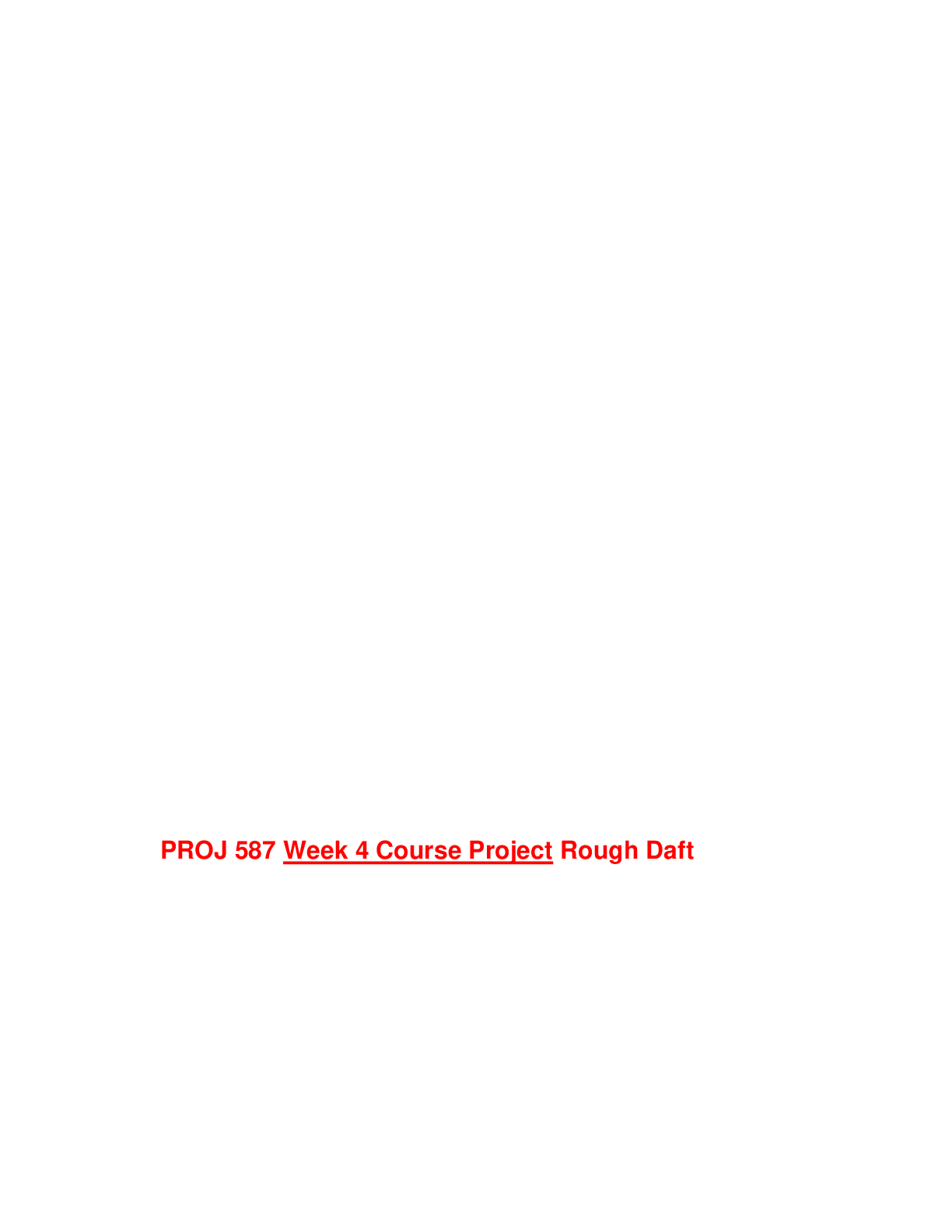
Reviews( 0 )
Recommended For You
Law> COURSE NOTES > INTERNATIONAL CRIMINAL LAW AND CONSTITUTIONAL LAW (All)
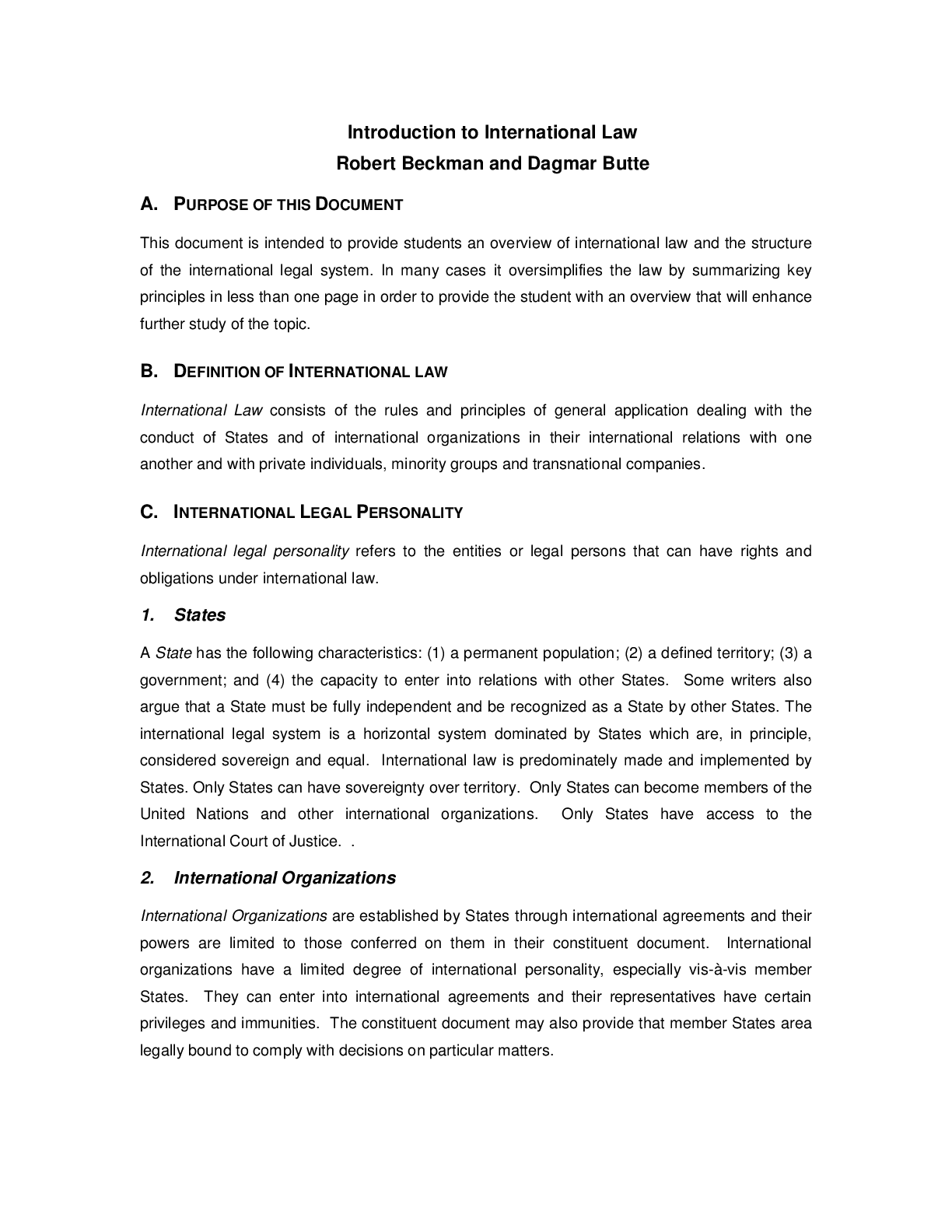
INTERNATIONAL CRIMINAL LAW AND CONSTITUTIONAL LAW
**International Criminal Law:** International Criminal Law (ICL) is a branch of international law that deals with offenses of a transnational nature that are considered serious crimes affecting the...
By Ernest Gichichi , Uploaded: Dec 20, 2023
$2
Law> COURSE NOTES > Criminal Procedure 1 CMP201-6/ Criminal Procedure 1 : CPR3701 CHAPTER 1 TO 11 CMP201-6 NOTES (University of South Africa) (All)

Criminal Procedure 1 CMP201-6/ Criminal Procedure 1 : CPR3701 CHAPTER 1 TO 11 CMP201-6 NOTES (University of South Africa)
NOTES Criminal Procedure 1 CMP201-6/ Criminal Procedure 1 : CPR3701 CHAPTER 1 TO 11 CMP201-6 NOTES(University of South Africa) A BASIC INTRODUCTION TO CRIMINAL PROCEDURE
By Kirsch , Uploaded: May 12, 2020
$7.5
*NURSING> COURSE NOTES > TEAS Overview; Preparing for the Test of Essential Academic Skills _TEAS TEAS. Math,Science, Reading ,English and Language Usage (All)

TEAS Overview; Preparing for the Test of Essential Academic Skills _TEAS TEAS. Math,Science, Reading ,English and Language Usage
TEAS Overview; Math,Science, Reading ,English and Language Usage Preparing for the Test of Essential Academic Skills/TEAS TEAS Overview Consists of 170 questions 150 questions scored 20 questions exp...
By Good grade , Uploaded: Sep 19, 2020
$9
*NURSING> COURSE NOTES > ATI Mental Health Nursing notes. Complete Study Notes for A score (All)
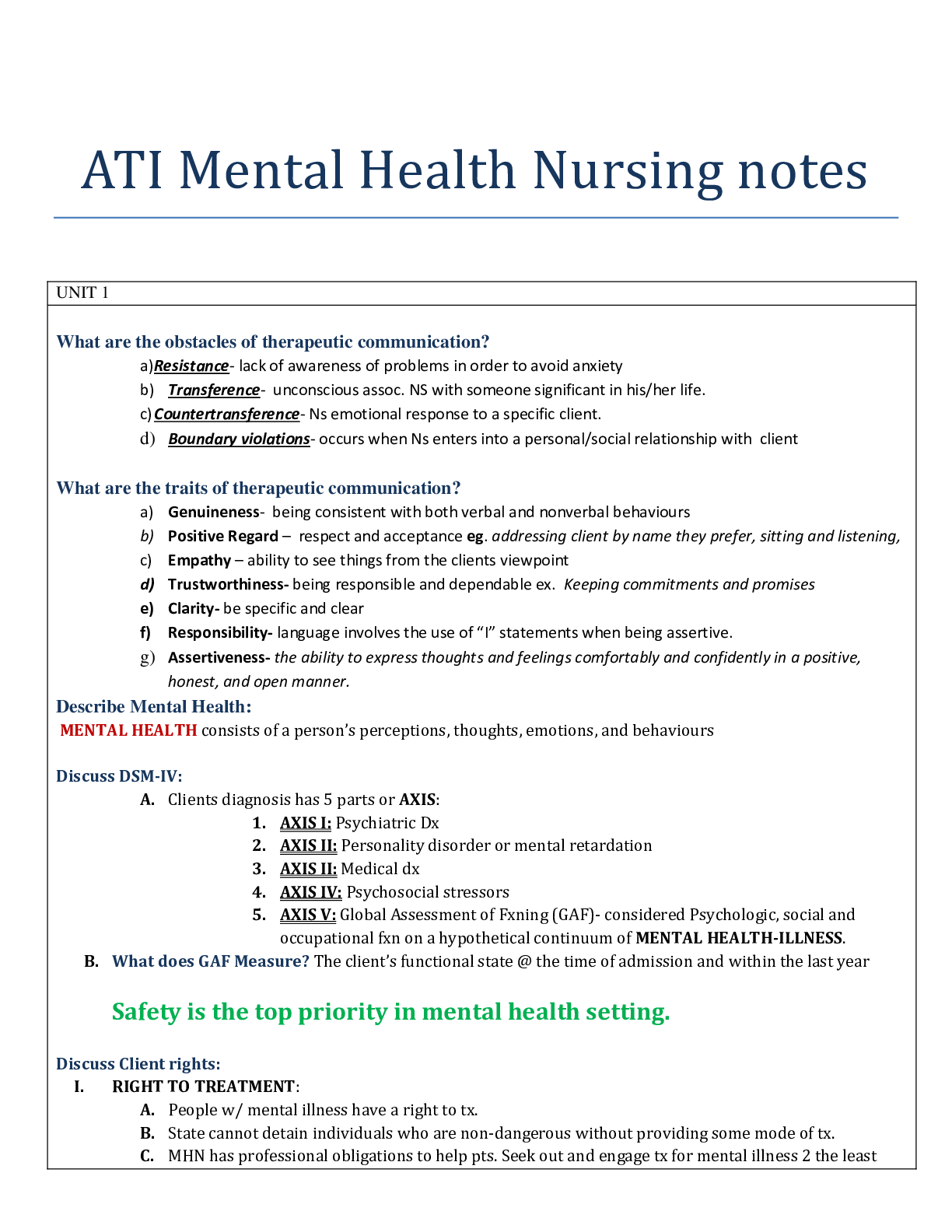
ATI Mental Health Nursing notes. Complete Study Notes for A score
What are the obstacles of therapeutic communication? What are the traits of therapeutic communication? a) honest, and open manner. Describe Mental Health: MENTAL HEALTH consists of a person’s per...
By Kirsch , Uploaded: Jun 11, 2020
$9.5
Biological Psychology> COURSE NOTES > Introduction To Human Anatomy & Physiology General (All)
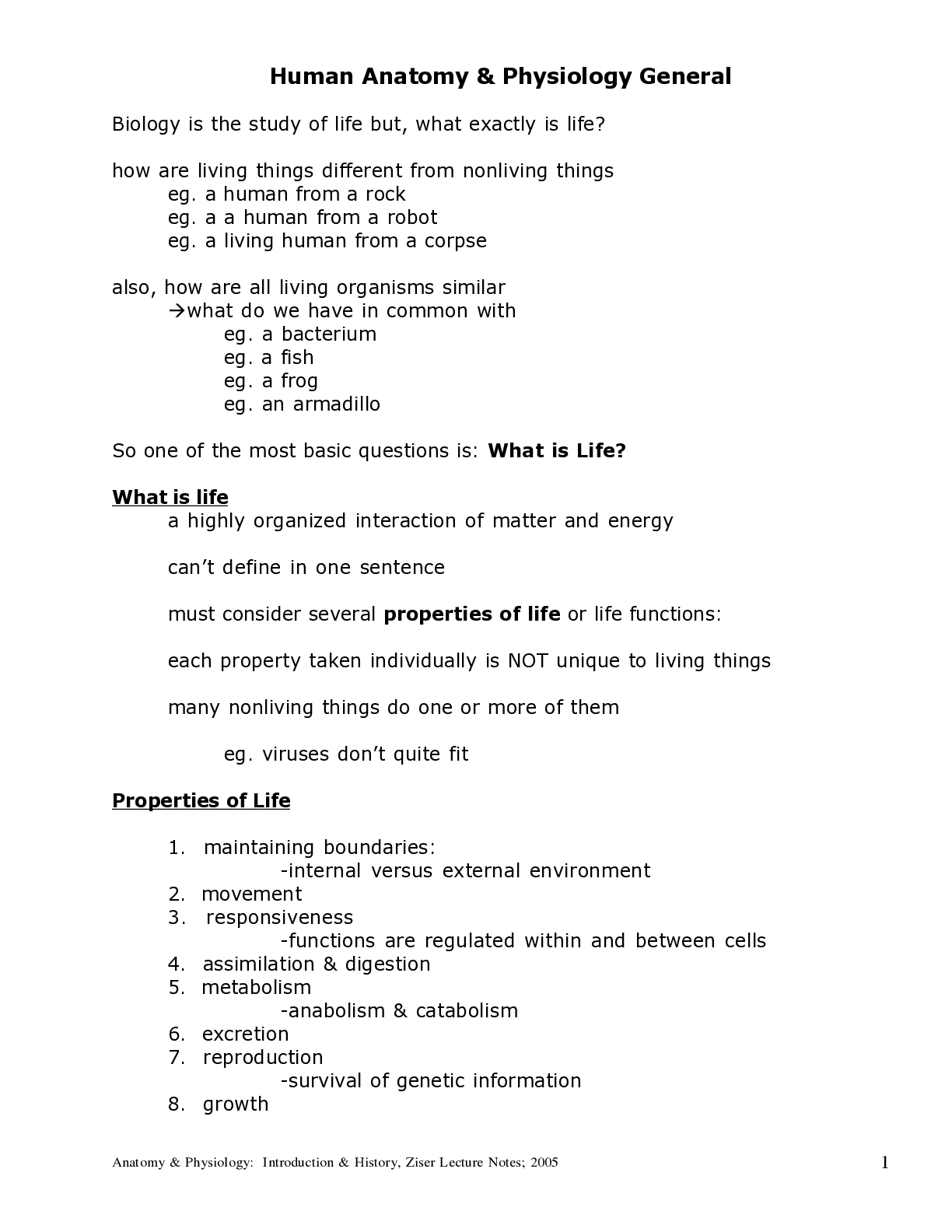
Introduction To Human Anatomy & Physiology General
Biology is the study of life but, what exactly is life? how are living things different from nonliving things eg. a human from a rock eg. a a human from a robot eg. a living human from a corpse a...
By henryICLOUD , Uploaded: Jun 27, 2023
$3.5
*NURSING> COURSE NOTES > VATI Nursing care of children focused review notes (All)
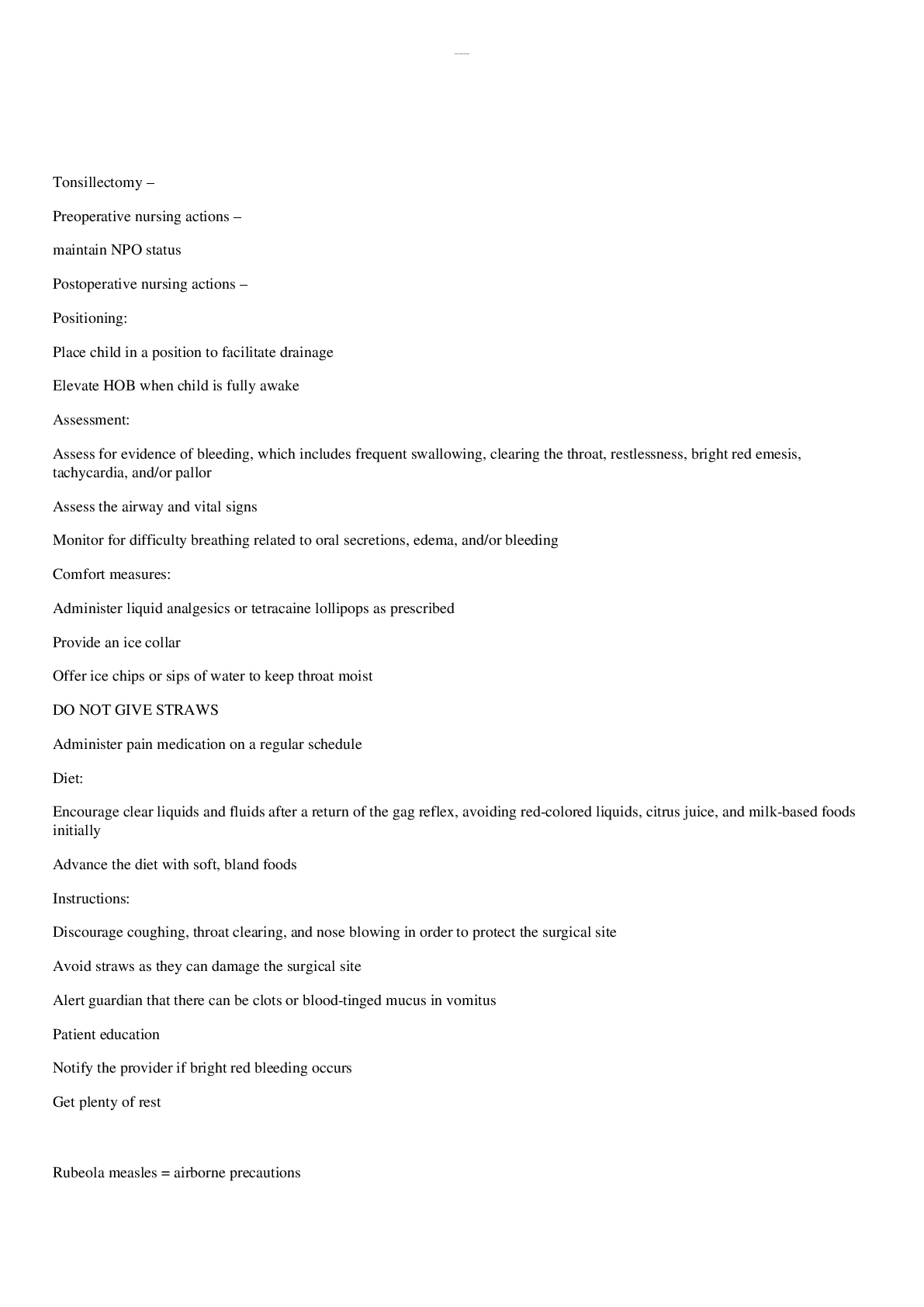
VATI Nursing care of children focused review notes
VATI Nursing care of children focused review notes
By ACADEMICTUTORIAL , Uploaded: Mar 27, 2023
$4
Accounting> COURSE NOTES > INTERMEDIATE ACCOUNTING 1 CASH AND CASH EQUIVALENTS- Complete Notes, Defitions and Financial Calculation Guidelines (All)

INTERMEDIATE ACCOUNTING 1 CASH AND CASH EQUIVALENTS- Complete Notes, Defitions and Financial Calculation Guidelines
INTERMEDIATE ACCOUNTING 1 CASH AND CASH EQUIVALENTS Definition of cash − As contemplated in accounting, cash includes money and any other negotiable instrument that is payable in money and accepta...
By CourseWorks,Inc , Uploaded: Mar 23, 2023
$6
*NURSING> COURSE NOTES > HESI A2 STUDY GUIDE (All)
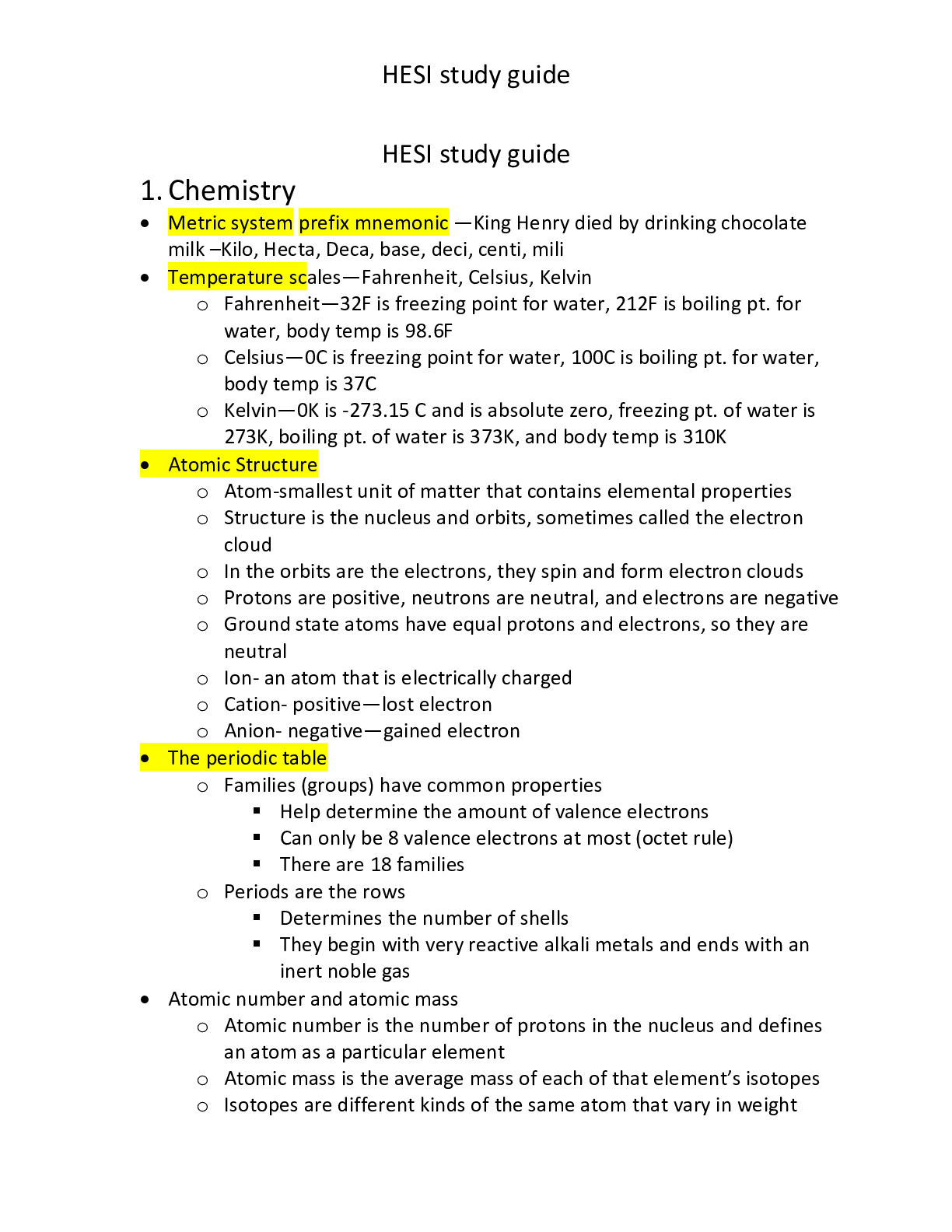
HESI A2 STUDY GUIDE
Mitochondria and chloroplasts- produce cellular energy; cellular respiration and photosynthesis Cellular membrane- protect, communicate, and passage of substances into and out of the cell • Bil...
By Dorcas Okumu , Uploaded: Mar 18, 2024
$6
*NURSING> COURSE NOTES > Grand Canyon University NRS 434V Health Assessment SICKLE CELL ANEMIA (All)

Grand Canyon University NRS 434V Health Assessment SICKLE CELL ANEMIA
Grand Canyon University NRS 434V Health Assessment SICKLE CELL ANEMIA What is Sickle Cell Anemia? • Most common form of Sickle Cell Disease • Hereditary and mainly affects persons of...
By QuizMaster , Uploaded: Mar 28, 2023
$7
Health Care> COURSE NOTES > CARE OF PEDIATRICS (All)

CARE OF PEDIATRICS
Pediatric care for child starts as an infant. Well-baby visits focus on keeping your baby well and providing guidance for the future. Your pediatrician sees your baby after they leave the hospital and...
By ApexStudies , Uploaded: Feb 29, 2024
$17
Document information
Connected school, study & course
About the document
Uploaded On
Jun 01, 2023
Number of pages
14
Written in
Additional information
This document has been written for:
Uploaded
Jun 01, 2023
Downloads
0
Views
61







